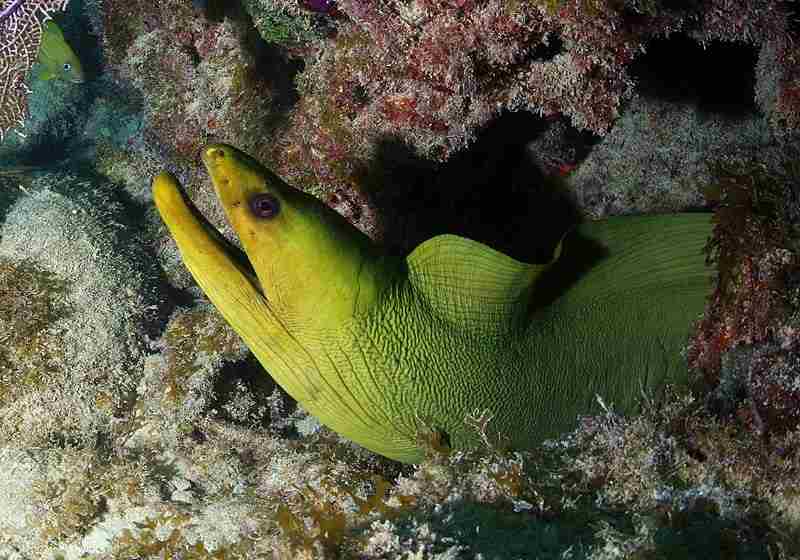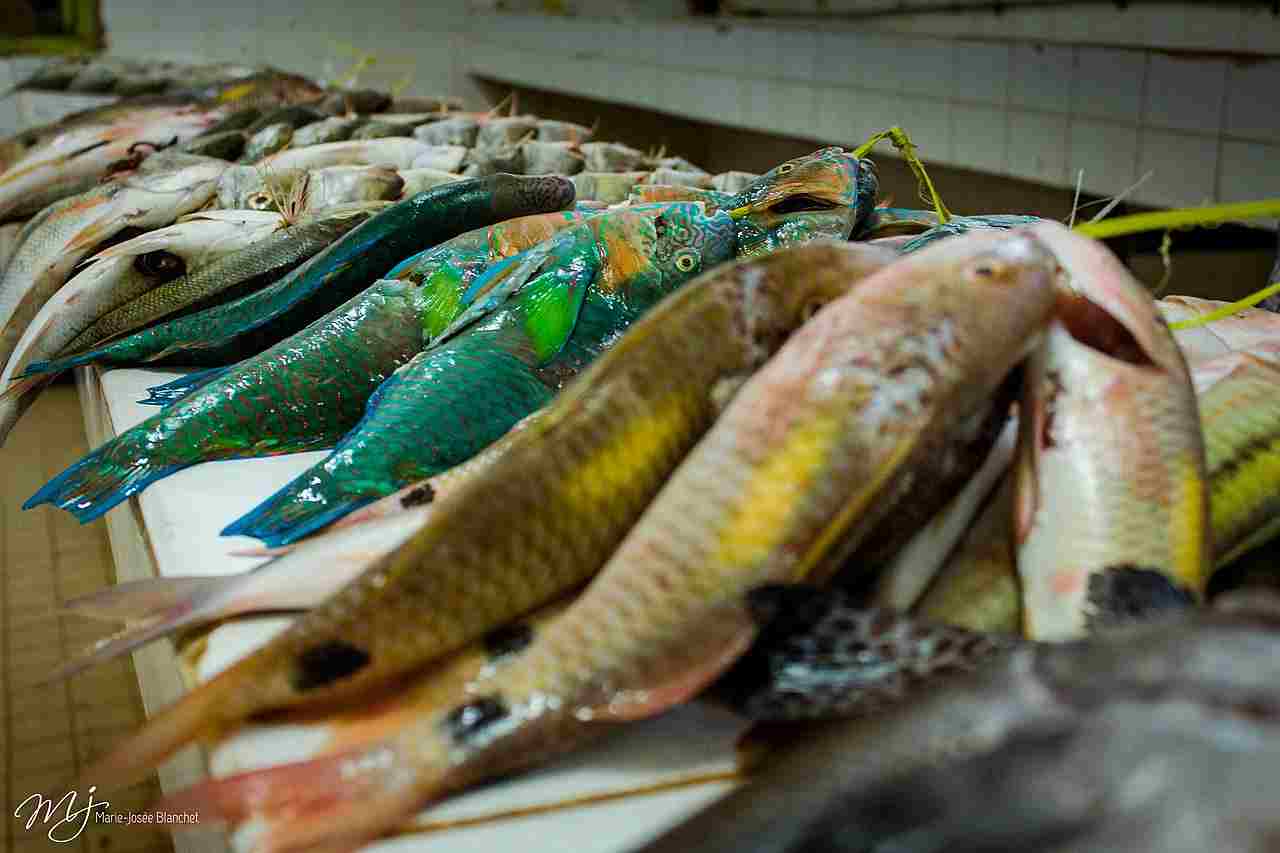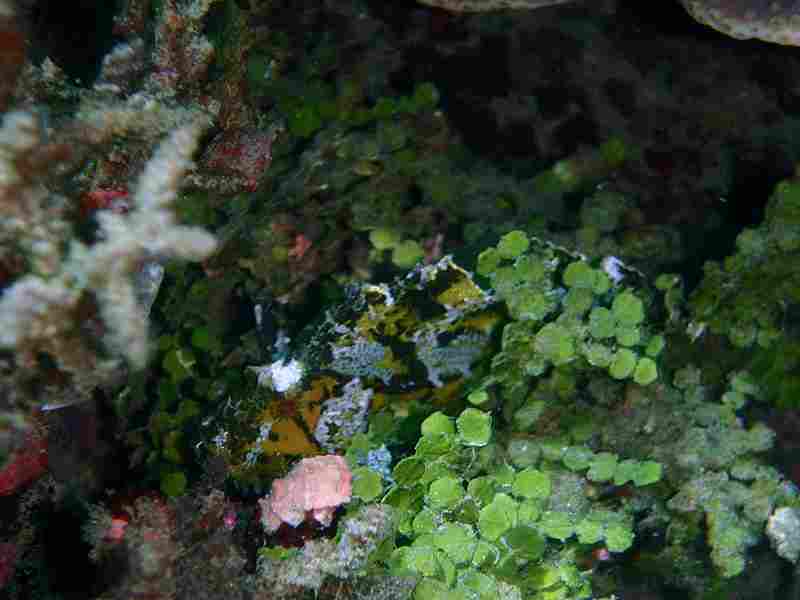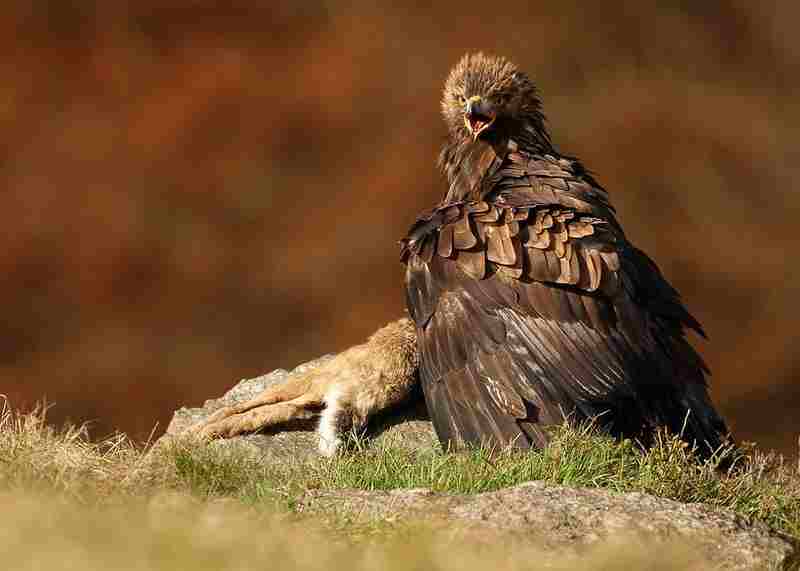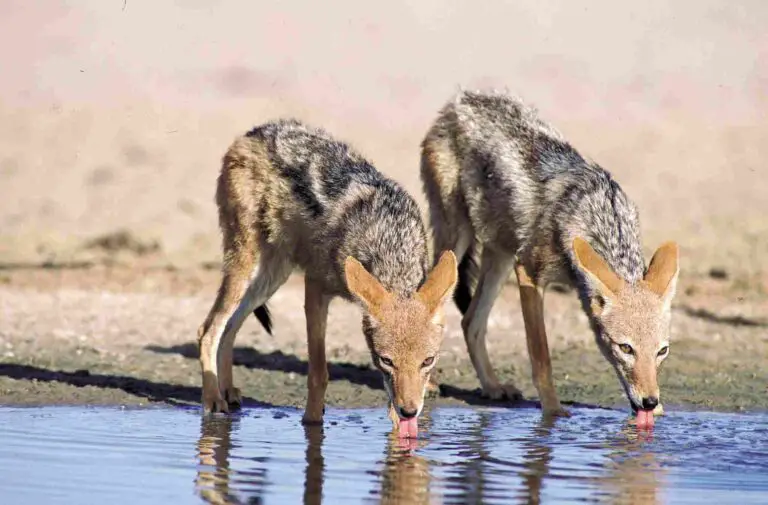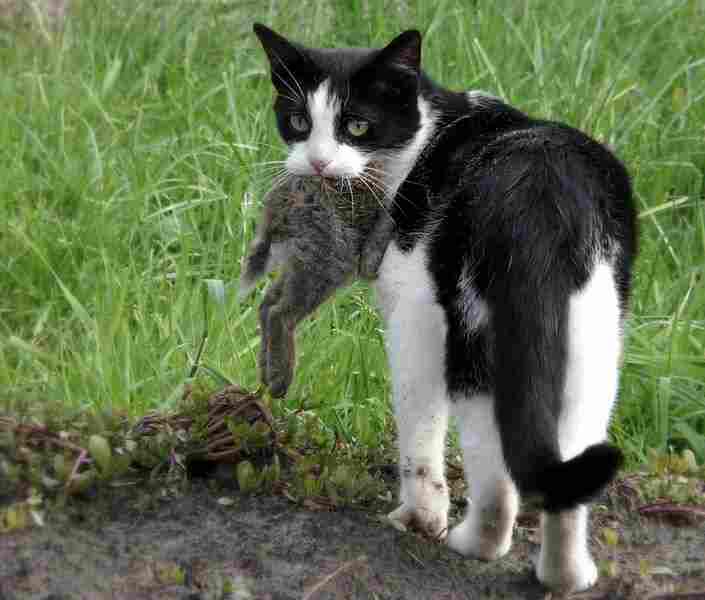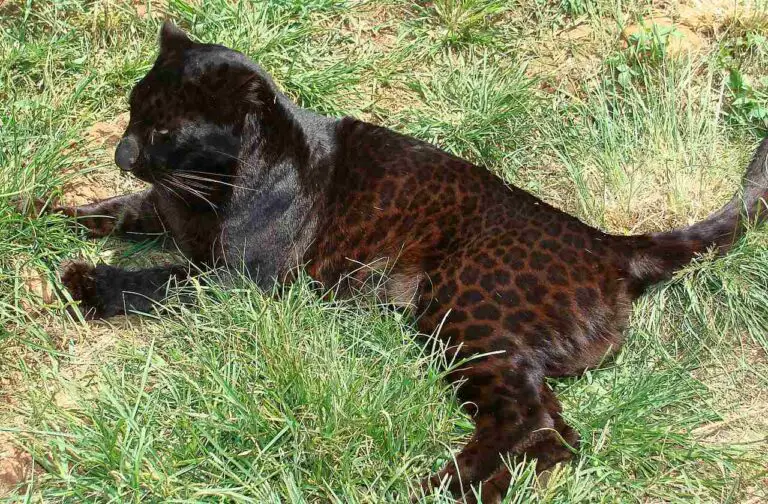Coral Reef Food Chain with Five (5) Trophic Levels and Decomposers
Coral reef food chain comprises of producers like seagrasses; primary consumers like parrotfish; secondary consumers like moray eel; tertiary consumers like horn shark; quaternary consumers like whale shark, and decomposers like fungi.
This article discusses the coral reef food chain with five trophic levels and decomposers, as follows;
1). Trophic Level 1: Producers in the Coral Reef (as part of the Coral Reef Food Chain)
Producers in the coral reef are organisms with photosynthetic capabilities, which capture and convert solar radiation (in the form of light) to chemical bioenergy, that can be assimilated and utilized by other organisms [8].
There are three major types of producers in the coral reef, which are namely; corals, seagrasses and algae.
*Corals (Zooxanthellae) as Producers in the Coral Reef
As the name implies, corals are the main building blocks of the coral reef system or structure.
They are classified under an organic group called cnidarians, and share a symbiotic relationship with zooxanthellae; which are a specie of photosynthetic algae [1].
Zooxanthellae usually inhabit the tissues of coral polyps.
They receive protection and shelter from the coral polyps, and in return provide them with energy and nutrients derived from photosynthesis.
Because of their symbiosis with photosynthetic algae, corals can be categorized as producers. They are the foundation of reef ecosystems, and contribute to food supply as ell as microhabitat creation, in the ocean.

*Seagrasses as Primary Producers in the Coral Reef
Seagrasses constitute another important group of producers in the coral reef.
They can be described as vascular, flower-producing aquatic plants that occur in shallow areas of marine ecosystems [13]; and are also prominent as producers in the overall ocean food chain.
Seagrasses are the result of multi-generational evolution, which has enabled them to thrive in partial or total submersion, in saline water.
Most species of seagrasses have notable photosynthetic efficiency, and therefore play an effective role as producers.
They are food sources for herbivorous marine animals, and contribute to the creation of microhabitat for various invertebrates, small fish, as well as insect larvae and other juvenile marine individuals.
*Algae as a Producer in the Coral Reef Food Chain
Algae are a group of diverse autotrophic organisms that are arguably the most dominant producers in most aquatic ecosystems.
They can be microscopic (microalgae) or macroscopic (macroalgae); where the latter groups includes even seaweeds [4].
Algae also come in diverse morphological forms, with different colorations. These diverse groups are exemplified by green, red, encrusting, leafy, and filamentous algae.
By contributing to the production of chemical energy, algae play a vital role in the coral reef biome; and serve as food as well as habitat for several organisms.
They are very important to the recycling of resources like nutrients, and play a role in carbon sequestration, in the ocean.
Organisms that feed on algae in the coral reef include invertebrates like mollusks, and herbivorous fish.
*Producers in the Red Sea Coral Reef
Three (3) producers in the Red Sea coral reef are; halodule seagrass, Halimeda algae, and acropora corals.
Halodule seagrass is fairly common in the Red Sea [3], and occurs in various sub-zones and microhabitats, including reefs. Its grows into meadows, and is a source of shelter and food for diverse marine organisms.

Halomeda algae is a green, calcareous specie of algae that occurs in the Red Sea coral reef biome; where it plays a role in habitat provision and reef stabilization/growth.
Acropora corals are a prominent genus of corals occurring in the Red Sea, which are known for their tabular, branching structure [7].
*Summary of Functions, of Producers in the Coral Reef
1. Photosynthetic production of energy and nutrients
2. Contribution to species richness and diversity
3. Stabilization of the ecosystem
4. Provision of microhabitat for organisms
Producers in the coral reef contribute to sustainability and ecological diversity through their photosynthetic activity, growth, and role as carbon sinks.
2). Trophic Level 2: Primary Consumers in the Coral Reef
Primary consumers in the coral reef are organisms that have herbivorous habits, and feed directly on primary producers like algae, seagrasses and corals.
These organisms occupy the second trophic level of the ecosystem, and are vital in their roles toward energy-transfer and nutrient-cycling.
They can be said to serve as a nutritional bridge that is used to transfer essential resources (energy, nutrients) from producers to higher consumers.
While many primary consumers in the coral reef are herbivores, several are also omnivorous; and exploit a wide range of food sources including plant matter and organic detritus.
Examples of Primary Consumers in the Coral Reef Food Chain
Examples of primary consumers in the coral reef are; sea urchins, herbivorous fish (like parrotfish), sea turtles, sponges, mollusks and crustaceans.
*Sea Urchins as Primary Consumers in the Coral Reef
Sea urchins are a group of invertebrates with a spiny morphology, that inhabit reefs and other zones of the ocean.
Their diet includes a significant amount of algae; which they supplement with other forms of organic matter within reach.
Sea urchins scrape algae of the surfaces of substrates like rocks in the ocean, using a specialized feeding structure called the Aristotle's lantern [14].
Their activities are effective for regulating/controlling the growth trends of algae; and preventing excessive algal blooming that can negatively impact the coral reef and its non-algal populations.
In terms of this role of population-regulation, sea urchins are particularly essential where other herbivores like small fish, are absent or poorly represented.

*Herbivorous Fish as Primary Consumers in the Coral Reef
Herbivorous fish in the coral reef include parrotfish and yellow tang [2].
They are often prominent among primary consumers in reef environments.
These fish are known to consume various species of algae, including encrusting and filamentous varieties; thereby regulating the rate and effect of algal growth.
Parrotfish, for example, graze on algae that grows on coral polyps.
Like other reef herbivores, they have feeding adaptations that include specialized dentition and mouthparts for alga-grazing from rock surfaces.
As earlier stated, their activities maintain the diversity and health of coral reefs through prevention of algae overgrowth.
*Herbivorous/Omnivorous Mollusks and Crustaceans as Primary Consumers in the Coral Reef Food Chain
Invertebrates like hermit crab and trochus snail, are consumers in the coral reef.
Hermit crabs feed on both micro and macro-algae, as well as other aquatic vascular and non-vascular plants.
Trochus snails graze on algae, as well as diatoms (phytoplankton) and cyanobacteria.
These herbivorous invertebrates help create space for the growth of coral reefs by preventing excessive algal blooming.
*Sponges as Primary Consumers in the Coral Reef
Sponges are organisms that survive through filter-feeding, and operate as primary consumers in coral reefs.
Being filter-feeders, they extract organic matter and nutrients from the water column.
They are known to feed on plankton, organic litter, and cyanobacteria. Their activities support marine nutrient-cycling, while helping to maintain the quality of water within their environment.
*Sea Turtles
Sea turtle species like hawksbill turtle (Eretmochelys imbricata) and green turtle (Chelonia mydas) are herbivorous [15], and feed on plant matter from algae and seagrasses in the coral reef. They help regulate the species-abundance of autotrophs on which they feed.

*Corals (Polyps) as Primary Consumers in the Coral Reef
Zooxanthellae which symbiotically coexist with coral polyps are photosynthetic producers.
However, corals also prey on phytoplankton [6] (along with some zooplankton), meaning that they can be correctly classified as producers and primary consumers, depending on the component of the symbiotic assemblage being discussed.
Functions and Importance of Primary Consumers in the Coral Reef Ecosystem
Functions and importance of primary consumers in the coral reef food chain/ecosystem include; algae-growth control, nutrient cycling, ecological resilience-building, and habitat creation.
*Algae-Growth Control by Primary Consumers in the Coral Reef
Sea urchins, fish, and other herbivorous primary consumers; control the growth of algae on reefs.
This is an essential function, because excessive algal growth is known to affect the survival and growth of corals in a negative manner [9].
Primary consumers maintain a state of population-balance between coral organic populations and algae, by feeding on the latter. This promotes the resilience and overall health of reefs.
*Nutrient Cycling
Primary consumers contribute immensely to nutrient cycling in the reef ecosystem.
They help in the transfer of nutrients and energy from lower to higher trophic levels, by consuming reef producers.
Their activities including feeding and excretion, influence the dynamics of nutrients in the water column; and these nutrients are essential to the survival of other reef organisms.
*Ecological Resilience-Building by Primary Consumers in Coral Reefs
Primary consumers contribute to the resilience of coral reef ecosystems by promoting the survival and growth of corals (through algae-population control).
Healthy primary consumer populations help maintain the integrity and balance of the reef, which leads to increase in biodiversity and long-term stability.
*Habitat Creation of Coral Reef Primary Consumers
Primary consumers like herbivorous crustaceans and mollusks, contribute to microhabitat-formation in coral reefs through their grazing activities.
These organisms cause spatial variations in the distribution and density of reef autotrophs/plants; which in turn produce crevices and enclosures in which other organisms can find shelter.
Juvenile fish, as well as insect larvae and other invertebrates, are examples of organisms that take advantage of such microhabitats.
3). Trophic Level 3: Secondary Consumers in the Coral Reef (as part of the Coral Reef Food Chain)
Secondary consumers in the coral reef are a group of organisms whose diet comprises mainly of primary consumers within their habitat; such as herbivorous mollusks, crustaceans and fish.
These organisms occupy the third trophic level of the food chain, and are crucial in their role, which involves energy and nutrient transfer from primary consumers to higher consumers (that is; tertiary and quaternary consumer-groups).
Coral reef secondary consumers are omnivores and carnivores.
Examples of Secondary Consumers in the Coral Reef Food Chain
Examples of secondary consumers in the coral reef food chain are; moray eel, other carnivorous reef fish, and large crustaceans (like lobster).
*Moray Eel as a Secondary Consumer in the Coral Reef
Moray eel is a carnivorous, predatory fish that can be found in the coral reef [10].
Its diet consists of smaller organisms including juvenile and herbivorous fish, cephalopods, and crustaceans.
The morphological features of moray eels include an elongate body, sharp teeth and powerful jaws which they use to capture and consume prey.
They are also well-adapted to their predatory role, and utilize a stealthy hunting strategy based on ambush, to acquire energy and nutrients that they need.

*Other Carnivorous Reef Fish that can be Classified as Secondary Consumers
Several species of carnivorous fish are secondary consumers in the coral reef ecosystem.
Their prey include invertebrates like crustaceans, and smaller fish.
Examples of such fish are; snappers, triggerfish, barracudas, and groupers.
Species of triggerfish in the coral reef include titan triggerfish (Balistoides viridescens), and Picasso triggerfish (Rhinecanthus aculeatus); both of which consume gastropods and crustaceans, and play a role in the regulation of prey populations.
Coral reef barracuda species include the great barracuda (Sphyraena barracuda), which is an opportunistic and predatory fish that is known to prey on small herbivorous fish like parrotfish, and occasionally on smaller carnivorous fish like snappers.
Their features include specialized teeth and jaws that are adapted for the capture and consumption of prey.
Due to the impact of their activities, these secondary consumers are important as components of the coral reef food chain; and play a role toward the ecological balance of their habitat.
*Large Crustaceans as Secondary Consumers in the Coral Reef
Large crustaceans in the coral reef can function as secondary consumers.
These organisms include lobsters, and can prey on small fish, as well as various marine invertebrates.
Spiny lobsters (Panulirus spp.) are predatory crustaceans and scavengers that consume various benthic organisms, along with mollusks, small crabs and fish.
In order to capture prey, large crustaceans are equipped with powerful claws.
Many of them are nocturnal, emerging from crevices at night in order to search for food.
*Functions and Importance of Secondary Consumers in the Coral Reef
The functions and importance of coral reef secondary consumers are; energy-transfer facilitation, population regulation, and trophic interaction.
1. Energy-Transfer Facilitation by Secondary Consumers in the Coral Reef
Secondary consumers facilitate the transfer of energy in coral reefs by efficiently transferring nutrients and energy from lower to higher trophic levels.
This occurs as they prey on primary consumers and assimilate the biomass of these organisms; subsequently giving the same biomass to higher consumers that prey on them.
2. Population Regulation by Secondary Consumers in the Coral Reef
Population sizes of primary consumers are regulated by secondary consumers, which prey on them.
Predation on herbivorous invertebrates and fish by secondary consumers, helps prevent overgrazing which can cause producer-resource depletion, and may impact the ecosystem adversely.
As a result, equilibrium is maintained in the coral reef. This phenomenon is described as the trophic cascade effect [12].
3. Trophic Interaction
Through their presence and activities, secondary consumers in the coral reef establish a dynamic of predator-prey interaction.
Such relationships between predators and prey increase and maintain the stability and diversity of coral reef communities, by influencing the distribution and (physiological, behavioral) adaptations of species in both categories.
*Status of the Reef Shark as a Secondary Consumer
Reef shark is a secondary consumer in coral reefs where there is low representation of smaller carnivores and omnivores like eels and lobsters.
As secondary consumers, their prey will include some crustaceans and small fish (which are primary consumers).
In other coral reef food chains where biodiversity is high, reef sharks will likely be classified as tertiary consumers; because of the presence of numerous lower species to occupy the secondary consumer level (trophic level 3), as well as larger species to form a fifth trophic level for quaternary consumers.
4). Trophic Level 4: Tertiary Consumers in the Coral Reef
Tertiary consumers in the coral reef are a group of organisms occupying the fourth trophic level of the food chain.
They are usually carnivorous or omnivorous, and can prey on primary and secondary consumers.
In the absence of quaternary consumers; these organisms function as apex predators, playing a vital role in the regulation of prey populations, and the maintenance of overall ecological balance.
*Examples of Tertiary Consumers in the Coral Reef
Tertiary consumers in the coral reef are predatory organisms that feed on primary and secondary consumers. Their activities help regulate the populations of these lower organisms, and facilitate the recycling of essential resources in their habitat.
Examples of tertiary consumers in the coral reef are; whitetip reef shark (Triaenodon obesus), and horn shark (Heterodontus francisci).
The whitetip reef shark is a coral reef tertiary consumer that feeds on crustaceans, octopuses; squids, and bony fishes in its habitat.
Whitetip reef sharks employ an opportunistic hunting strategy that focuses more on small prey.
Horn sharks occur in rocky parts of the coral reef, and rely heavily on invertebrate populations (including sea urchins, mollusks and crustaceans) for food [5]. They are smaller and less-dominant than larger shark species in their habitat.

*Functions and Importance of Tertiary Consumers in the Coral Reef Food Chain
Functions and importance of tertiary consumers in the coral reef ecosystem are; energy transfer, trophic cascade, and population control.
1. Energy Transfer by Tertiary Consumers in the Coral Reef
Tertiary consumers transfer both biomass and energy efficiently, from organisms in lower trophic levels, to themselves and other advanced consumers in higher trophic levels.
Through predation, they assimilate biomass of other consumers for their growth, reproduction and general metabolism. This supports the functioning of the ecosystem and the continuous flow of energy
2. Trophic Cascade by Tertiary Consumers in the Coral Reef
Tertiary consumers contribute to the trophic cascade effect in coral reefs.
Their presence in the food chain has a dynamic effect on the populations of lower consumers, as well as producers; influencing the abundance and distribution of these organic groups.
3. Population Control by Coral Reef Tertiary Consumers
Tertiary consumers in the coral reef help to regulate the sizes of organic populations in lower trophic levels including secondary and primary consumers.
They help prevent irregularities in relative population size; which could otherwise have negative implications for the ecosystem.
*Status of Reef Squid as a Consumer in the Coral Reef Ecosystem
Reef squids like bigfin reef squid and Caribbean reef squid, are not tertiary consumers in the coral reef ecosystem. Rather, they are secondary consumers, and prey on primary consumers like small herbivorous fish and crustaceans.
As predators, they have developed physiological and behavioral adaptations that help them capture and consume prey.
One of the notable adaptations of reef squids is their camouflage, which includes the ability to change color, to blend into their surroundings [11].

5). Trophic Level 5: Quaternary Consumers in the Coral Reef (as part of the Coral Reef Food Chain)
Quaternary consumers in the coral reef are a group of organisms occupying the absolute highest level of the coral reef food chain, and capable of feeding on all consumer groups including primary, secondary, tertiary, and vulnerable fellow quaternary consumers.
These consumers are apex predators, and their activities have notable influence in the dynamics and structure of the reef sub-biome.
It must be noted that quaternary consumers are represented only in coral reefs with immense biodiversity, as most average ecosystems would have tertiary consumers (trophic level 4) as the apex level.
Activities of coral reef quaternary consumers lead to the regulation of organic population sizes, and the maintenance of overall diversity, as well as ecological structure, in their habitat.
Examples of Quaternary Consumers in the Coral Reef
Examples of quaternary consumers in the coral reef are; saltwater crocodile (Crocodylus porosus), Caribbean reef shark (Carcharhinus perezi), and whale shark (Rhincodon typus).
*Saltwater Crocodile as a Quaternary Consumer in the Coral Reef
The saltwater crocodile may be found occupying the highest trophic level of the coral reef food chain.
Their diet primarily consists of fish and crustaceans; which they supplement with other food sources.
Saltwater crocodiles play an important role in the regulation of prey populations, and thereby contribute to ecological balance on a large scale.
Unlike other reef consumers, saltwater crocodiles are not always present within the reef environment, or represented in large numbers as members of reef communities. However; they can be very active as predators when they operate in the reef zone.

*Caribbean Shark as a Quaternary Consumer in the Coral Reef
Caribbean shark is an apex predator in the coral reef food chain.
Its diet consists primarily of fish, including smaller carnivorous species like snappers and groupers.
Like other consumers, Caribbean sharks influence the population-dynamics of their prey; as well as the distribution of organisms in the reef, so that their activities result in the trophic cascade effect.
*Whale Shark as a Quaternary Consumer in the Coral Reef
Whale shark is a predator whose massive size compared to other sharks places it above them in the trophic hierarchy.
It is however a filter feeder, and consumes mainly planktonic organisms like crustaceans, alongside small schooling fish.
Whale sharks play an effective role in nutrient cycling not only in the coral, reef, but in many other zones of the marine ecosystem; as a result of the large scale of their feeding.
*Functions and Importance of Quaternary Consumers in the Coral Reef Ecosystem
Quaternary consumers in the coral reef function as keystone species, in addition to their roles in population control and ecosystem resilience-building.
1. Quaternary Reef Consumers as Keystone Species
Quaternary consumers in the coral reef may be considered keystone species; because of their position at the top of the food chain.
This position implies that they have a disproportionately-immense influence in the stability of the reef ecosystem relative to their population size or abundance.
Quaternary consumers influence the distribution, abundance and adaptation of their prey, which has a ripple effect on all trophic levels.
2. Population Control by Quaternary Consumers in the Coral Reef
Top-down control is exerted by quaternary consumers over the lower trophic populations of coral reefs; which include primary, secondary and tertiary consumers.
Preying on these lower organisms helps regulate their abundance; and prevents overpopulation and gross imbalances in relative abundance.
3. Ecological Resilience-Building by Reef Quaternary Consumers
Quaternary consumers in the coral reef are crucial to the establishment and maintenance of ecologic resilience.
Their predation protects some organic groups and resources from depletion due to uncontrolled population growth. This enables the ecosystem to withstand the effects of sudden environment change.
6). Trophic Level 6: Decomposers in the Coral Reef
Decomposers in the coral reef are important in their role, toward the breakdown of organic matter and recycling of used nutrients (contained in this organic matter) back into the food chain.
In coral reefs, biodegradation is facilitated mainly by the decomposers, and is an essential process for sustaining the ecosystem.
Examples of Decomposers in the Coral Reef
Three examples of decomposers in the coral reef are; fungi, bacteria, and detrivores like polychaete worms.
Fungi are important decomposers in the coral reef.
They break down organic matter in the form of waste materials and organic remains of algae and animals.
Bacteria are particularly needed to initiate the process of decomposition of organic matter in the coral reef. Their activities lead to the conversion of organic matter to inorganic minerals.
Some important biogeochemical cycles in the ocean, like phosphorus and nitrogen cycles, are driven significantly by bacteria.
Detrivores include organisms in the coral reef, that feed on organic litter or detritus, which includes waste materials and remains of dead reef organisms.
Examples of coral reef detrivores are; polychaete worms, shrimps, crabs, sea cucumbers, and some mollusks.
Functions and Importance of Decomposers in the Coral Reef Food Chain
The functions and importance of detrivores in the coral reef are; waste recycling, nutrient-cycling, facilitation of energy flow, and maintenance of ecosystem health.
1. Waste Recycling by Decomposers in the Coral Reef
Decomposers help recycle waste products from reef organisms, through biodegradation.
They remove dead organisms and excrement, which they cause to decompose; thereby preventing the accumulation of organic matter and growth of pathogens that could affect water quality and nutrient balance.
2. Facilitation of Energy Flow by Decomposers in the Coral Reef
Energy flow in the coral reef is substantially facilitated by decomposers.
Breaking down organic matter is a step toward the release of stored energy that can be used by other reef organisms in all trophic levels.
3. Nutrient Cycling by Coral Reef Decomposers
Decomposers in the coral reef release nutrients like phosphorus, nitrogen and carbon through their activities,
These nutrients are subsequently taken up by producers, so that the coral reef food chain remains functional.
Conclusion
The coral reef food chain comprises of;
1. Producers
2. Primary Consumers
3. Secondary Consumers
4. Tertiary Consumers
5. Quaternary Consumers
6. Decomposers
References
1). Björn, L. O.; Ekelund, N. (2006). "Corals and zooxanthellae - A marine partnership." Svensk Botanisk Tidskrift 100(4):263-270. Available at: https://www.researchgate.net/publication/287073996_Corals_and_zooxanthellae_-_A_marine_partnership. (Accessed 2 July 2023).
2). Bogeberg, M.; Kane, C. N.; Tissot, .B. N. (2014). "Habitat associations of yellow tang (Zebrasoma flavescens) from shallow to upper mesophotic coral reefs (3- 40 m) in West Hawaii." Western Society of Naturalists, Tacoma, WA. Available at: https://www.researchgate.net/publication/268687467_Habitat_associations_of_yellow_tang_Zebrasoma_flavescens_from_shallow_to_upper_mesophotic_coral_reefs_3-_40_m_in_West_Hawaii. (Accessed 2 July 2023).
3). El Shaffai, A.; Rouphael, A.; Abdulla, A. (2011). "Field Guide to Seagrasses of the Red Sea." International Union for the Conservation of Nature. Available at: https://www.researchgate.net/publication/266031410_Field_Guide_to_Seagrasses_of_the_Red_Sea. (Accessed 2 July 2023).
4). Fong, P.; Paul, V. J. (2011). "Coral Reef Algae". Coral Reefs: An Ecosystem in Transition (pp.241-272). Available at: https://doi.org/10.1007/978-94-007-0114-4_17. (Accessed 2 July 2023).
5). Fuentes, C. C.; Simental-Anguiano, M. R.; Galván-Magaña, F.; Medina, M. A. (2020). "Feeding habits of the horn shark Heterodontus francisci (Girard, 1855) in the northwest of Baja California Sur, Mexico." Journal of Applied Ichthyology 36(5). Available at: https://doi.org/10.1111/jai.14004. (Accessed 2 July 2023).
6). Goldberg, W. M. (2018). "Coral Food, Feeding, Nutrition, and Secretion: A Review." Results Probl Cell Differ. 2018;65:377-421. Available at: https://doi.org/10.1007/978-3-319-92486-1_18. (Accessed 2 July 2023).
7). Guzner, B.; Novoplansky, A.; Chadwick, N. (2007). "Population dynamics of the reef-building coral Acropora hemprichii as an indicator of reef condition." Marine Ecology Progress Series 333:143-150. Available at: https://doi.org/10.3354/meps333143. (Accessed 2 July 2023).
8). Kelly, L. W.; Haas, A.F.; Nelson, C. E. (2018). "Ecosystem Microbiology of Coral Reefs: Linking Genomic, Metabolomic, and Biogeochemical Dynamics from Animal Symbioses to Reefscape Processes." American Society for Microbiology, mSystems® 3(2):e00162-17. Available at: https://doi.org/10.1128/mSystems.00162-17. (Accessed 2 July 2023).
9). Littler, M. M.; Littler, S. D.; Brooks, B. (2006). "Harmful algae on tropical coral reefs: Bottom-up eutrophication and top-down herbivory." Harmful Algae 5(5):565-585. Available at: https://doi.org/10.1016/j.hal.2005.11.003. (Accessed 2 July 2023).
10). Matic-Skoko, S.; Tutman, P.; Petrić, M.; Skaramuca, D.; Đikić, D.; Lisičić, D.; Skaramuca, B. (2011). "Mediterranean moray eel Muraena helena (Pisces: Muraenidae): biological indices for life history." Aquatic Biology 13(3):275-284. Available at: https://doi.org/10.3354/ab00373. (Accessed 2 July 2023).
11). Nakajima, R.; Laibner, Z., Kuba, M. J.; Gutnick, T.; Iglesias, T. L.; Asada, K.; Nishibavashi, T.; Miller, J. (2022). "Squid adjust their body color according to substrate." Springer Nature, Scientific Reports 12(1):5227. Available at: https://doi.org/10.1038/s41598-022-09209-6. (Accessed 2 July 2023).
12). Shanafelt, D. W.; Loreau, M. (2018). "Stability trophic cascades in food chains." Royal Society Open Science 5(11):180995. Available at: https://doi.org/10.1098/rsos.180995. (Accessed 2 July 2023).
13). Short, C. A.; Novak, A. (2016). "Seagrasses." The Wetland Book. Available at: https://doi.org/10.1007/978-94-007-6173-5_262-1. (Accessed 2 July 2023).
14). Smith, J.; Garcia, S. C. (2021). "Variation in purple sea urchin (Strongylocentrotus purpuratus) morphological traits in relation to resource availability." PeerJ 9(1–2). Available at: https://doi.org/10.7717/peerj.11352. (Accessed 2 July 2023).
15). von Brandis, R. G.; Mortimer, J.; Reilly, B. K.; van Soest, R.; Branch, G. (2014). "Diet Composition of Hawksbill Turtles (Eretmochelys imbricata) in the Republic of Seychelles." Available at: https://www.academia.edu/69721210/Diet_Composition_of_Hawksbill_Turtles_Eretmochelys_imbricata_in_the_Republic_of_Seychelles. (Accessed 2 July 2023).
